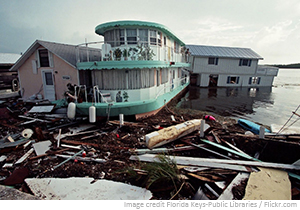
$1.9 billon. That is the estimated dollar amount the recent historic floods in Houston Texas will cost to return life and business back to normal according to the Houston Business Journal. Now almost every major weather service is reporting that, due to weather-related pattern shifts such as La Niña, the 2016 hurricane season may be more active than any over the past three years. Experts at AccuWeather warn that those living along the Atlantic coast should be vigilant, as tropical storms Bonnie and Colin have already appeared early in the Atlantic hurricane season, which typically spans from June through November. Historically, seasons which have tropical storm activity during the months of May, June and July have a higher likelihood of becoming normal or above-normal throughout the season. The National Oceanic and Atmospheric Administration (NOAA) predicts a 70% likelihood of 10 to 16 named storms, of which 4 to 8 could become hurricanes.
It only takes one storm to create a disaster for your business, regardless of whether storm activity levels are high or low. Businesses in coastal and near-coastal regions should prepare and take several precautions every hurricane season. Here are a few considerations:
- Building damage related to tropical storms can be caused by high wind, debris, wind-driven heavy rain, storm surges and flooding. Determining the initial cause of damage to the property can be critical during the post-damage assessment period. Fire, arson and looting are unfortunately not uncommon after hurricanes when properties are most vulnerable.
- Marine equipment and offshore operations are common to coastal industries and damage to barges, cargo and offshore structures can be extensive in the aftermath of a major tropical storm. Adjusters skilled in marine operations, including surveying and adjusting to recovery and loss control, are vital to ensure that damages are accurately captured to begin the process of recovery.
- After a hurricane, assessing the immense scope of loss to business and personal contents within a structure can be overwhelming to both the insured and the adjuster. Personal property and business property losses require the same attention to detail as a building claim, especially when events such as looting are involved. An accurate inventory protects businesses against loss, while also avoiding potential inflation of loss. The level of thoroughness needed for content adjusting is a different skillset than that required for building adjusting.
- The Atlantic hurricane season not only wreaks havoc in U.S. coastal cities, but also those of islands in the Caribbean, as well as in Mexico. Of note, NOAA also predicts a normal or above-normal forecast for the eastern Pacific and central Pacific regions. Widespread damage throughout a multi-national region requires not only a fast, experienced response – it also requires professionals who have a complete understanding and expertise in local markets and conditions which may differ from those in the mainland U.S.
Catastrophe team adjusters are experts in assessing and handling all types of disasters, whether they are natural or man-made, with the goal of making everything right and stable again. While we still can’t prevent storms or know for sure what Mother Nature has in store for 2016, you can take action now to be prepared should your business or property be impacted by a hurricane or other major weather event this year. Benjamin Franklin said it simple and best, “By failing to prepare, you are preparing to fail.”
Please feel free to share your ideas and questions with us; the Vericlaim Catastrophe Response Team is available to help meet the needs of your organization.
John Hinz, AIC, Vice President Vericlaim, a Sedgwick company